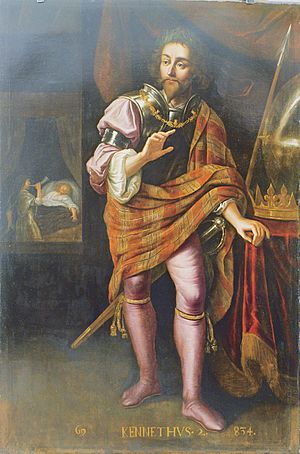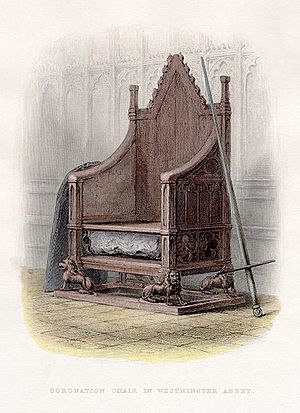Kenneth MacAlpin facts for kids
Quick facts for kids Kenneth MacAlpin |
|||||||||
|---|---|---|---|---|---|---|---|---|---|
| King of Alba (more...) | |||||||||
| Reign | 843 – 13 February 858 | ||||||||
| Predecessor | Title established | ||||||||
| Successor | Donald I | ||||||||
| King of the Picts | |||||||||
| Reign | 843 – 13 February 858 | ||||||||
| Predecessor | Drest X | ||||||||
| Successor | Donald I | ||||||||
| King of Dál Riada | |||||||||
| Reign | 841 – 850 | ||||||||
| Predecessor | Alpín mac Echdach | ||||||||
| Successor | Title disestablished | ||||||||
| Born | 810 Iona |
||||||||
| Died | February 13, 858 (aged 47–48) Forteviot, Perthshire, Scotland |
||||||||
| Burial | Iona Abbey | ||||||||
| Issue |
|
||||||||
|
|||||||||
| Medieval Gaelic | Cináed mac Ailpin | ||||||||
| House | Alpin | ||||||||
| Father | Alpín mac Echdach | ||||||||
Kenneth MacAlpin (Medieval Gaelic: Cináed mac Ailpin, Modern Scottish Gaelic: Coinneach mac Ailpein; 810 – 13 February 858) was a very important king in early Scottish history. He was King of Dál Riada (841–850), King of the Picts (843–858), and the first King of Alba (843–858). He is often called Kenneth I.
Kenneth inherited the throne of Dál Riada from his father, Alpín mac Echdach. He then conquered the kingdom of the Picts between 843 and 850. He wanted to unite all of Scotland and bring the Picts into his kingdom. Because of his success, he was later called An Ferbasach, which means "The Conqueror". He made Forteviot the capital of his new kingdom. Kenneth also fought against the Britons from the Kingdom of Strathclyde and the invading Vikings. He moved important religious items, like the Stone of Scone, from an old abbey on Iona to his new lands.
Kenneth I is traditionally seen as the founder of Scotland, which was first known as Alba. Even so, he and the kings after him were still called "King of the Picts". Some old writings say Kenneth was the first Scottish lawgiver, but we don't have any details about the laws he made.
Contents
Kenneth's Family Background
Kenneth's father was Alpín mac Echdach, who was the King of Dál Riada. This kingdom was located in what is now western Scotland. Alpín's family line was connected to earlier kings of Dál Riada.
There isn't much information about Kenneth's father, Alpín. Some old records say he ruled from 841 to 843. One story from the late 1200s says Alpín defeated the Picts in one battle but was later killed by them in another. This happened around 834 or 840.
It's thought that Kenneth's mother might have been a Pictish princess. In Pictish tradition, a woman from the royal family could pass on the right to the crown. This connection would have given Kenneth a strong claim to the Pictish throne.
Kenneth I had at least one brother, Donald I. Donald later became king after Kenneth.
Kenneth's Life and Reign
Early Years as King
Kenneth MacAlpin was likely born around 810 on the island of Iona in Scotland. After his father died, Kenneth became King of Dál Riada. His official crowning happened around 840 or 841. A key source for Kenneth's life is the Chronicle of the Kings of Alba. This writing from the 900s describes the reigns of Scottish kings from Kenneth I to Kenneth II.
Conquering the Picts
The Chronicle of the Kings of Alba says that Kenneth entered the land of the Picts in his second year as King of Dál Riada. He defeated the Picts and ruled their lands for 16 years. Other records, like the Annals of Ulster, say he became King of the Picts in 842 or 843. Most historians today agree that he became king in 843.
In the early 800s, Dál Riada faced many problems. The kingdom was mostly mountains, and much of the land was not good for farming. Also, Vikings had taken over the western islands (the Hebrides) and were attacking Dál Riada's borders. These challenges likely pushed Kenneth to attack the Picts.
The Pictish kingdom had become weaker after the death of their king, Eóganan mac Óengusa, in 839. Several kings ruled for very short times after him. Many sources from later periods say that the kingdoms of the Picts and the Scots joined together around 850. Some stories even say the last Pictish King was killed in Forteviot or Scone. This might refer to a legend called "MacAlpin's treason," where Pictish nobles were supposedly tricked and killed by the Scots.
Old records don't give many details about how Kenneth conquered the Picts. Historians think Kenneth might have been related to the Pictish kings through his mother or wife. It's likely Kenneth defeated the Pictish leaders and their armies, then took control of their country. One record mentions only one battle during his campaign, suggesting the Picts might not have fought back much.
Becoming King of Alba
After Kenneth took over the Pictish kingdom, a new kingdom was formed. It was called Alba in Gaelic, which later became known as Scotia and then Scotland. Kenneth is listed as the first King of Scotland in later royal records. However, modern historians believe the full joining of the kingdoms happened later. Kenneth's biggest achievement was creating a new royal family, the Alpínid dynasty. This family aimed to rule all of Scotland. Under them, the Scots and Picts blended together, and the Pictish language and traditions slowly disappeared.
After the Pictish lands were conquered, many Scots from Dál Riada moved into the Pictish areas. The old lists of Pictish and Dál Riada kings end around 850, showing that these separate titles stopped existing. Kenneth I and his government moved to the Pictish lands. It's possible that Scots had already settled there before the war. This might be why Scone was chosen as the new capital.
Kenneth moved important religious items from an old abbey on Iona to Dunkeld around 848 or 849. Life on Iona had become too dangerous because of Viking raids. The special stone used for coronations was also moved from Iona to Scone. This stone is now famous as the Stone of Scone.
The Chronicle of the Kings of Alba also tells us about other events during Kenneth's reign. He attacked Lothian in the Kingdom of Northumbria six times. He captured and destroyed towns like Melrose and Dunbar. The Celtic Britons from the Kingdom of Strathclyde also attacked Kenneth's kingdom and burned Dunblane. Additionally, Viking raiders attacked Pictish lands, destroying areas "from Clunie to Dunkeld".
Kenneth made his kingdom stronger by arranging marriages between his daughters and the kings of neighboring states, like Strathclyde and Ireland. The Chronicle of Melrose says Kenneth was one of the first Scottish lawgivers, but his laws have not survived.
Death and Succession
Kenneth died in 858, according to the Annals of Ulster. The Chronicle of the Kings of Alba states he died in February in Forteviot from a tumour. Historians believe the date was likely February 13. Kenneth was buried in Iona Abbey.
In his kingdom, the next ruler was chosen by a system called tanistry. This meant that Kenneth's brother, Donald, became king instead of Kenneth's oldest son. After Donald I died, Kenneth's sons, Causantín mac Cináeda and Áed mac Cináeda, became kings. The Alpínid dynasty, which ruled Scotland until the early 1000s, was established during this time.
Family
We don't know the name of Kenneth's wife. Some people think she might have been a Pictish princess. Kenneth had several children:
- Causantín mac Cináeda (ruled 862–877), who became King of Alba.
- Áed of the White Flowers (ruled 877–878), who also became King of Alba.
- An unknown daughter. She married Rhun ab Arthgal (ruled 872–878), the King of Strathclyde. They had a son named Eochaid.
- Máel Muire ingen Cináeda. She married Áed Findliath (ruled 862–879), who was the High King of Ireland.
There is also a theory that the wife of Amlaíb Conung (ruled 853–871), the King of Dublin, was another daughter of Kenneth.
See also
 In Spanish: Kenneth I de Escocia para niños
In Spanish: Kenneth I de Escocia para niños



